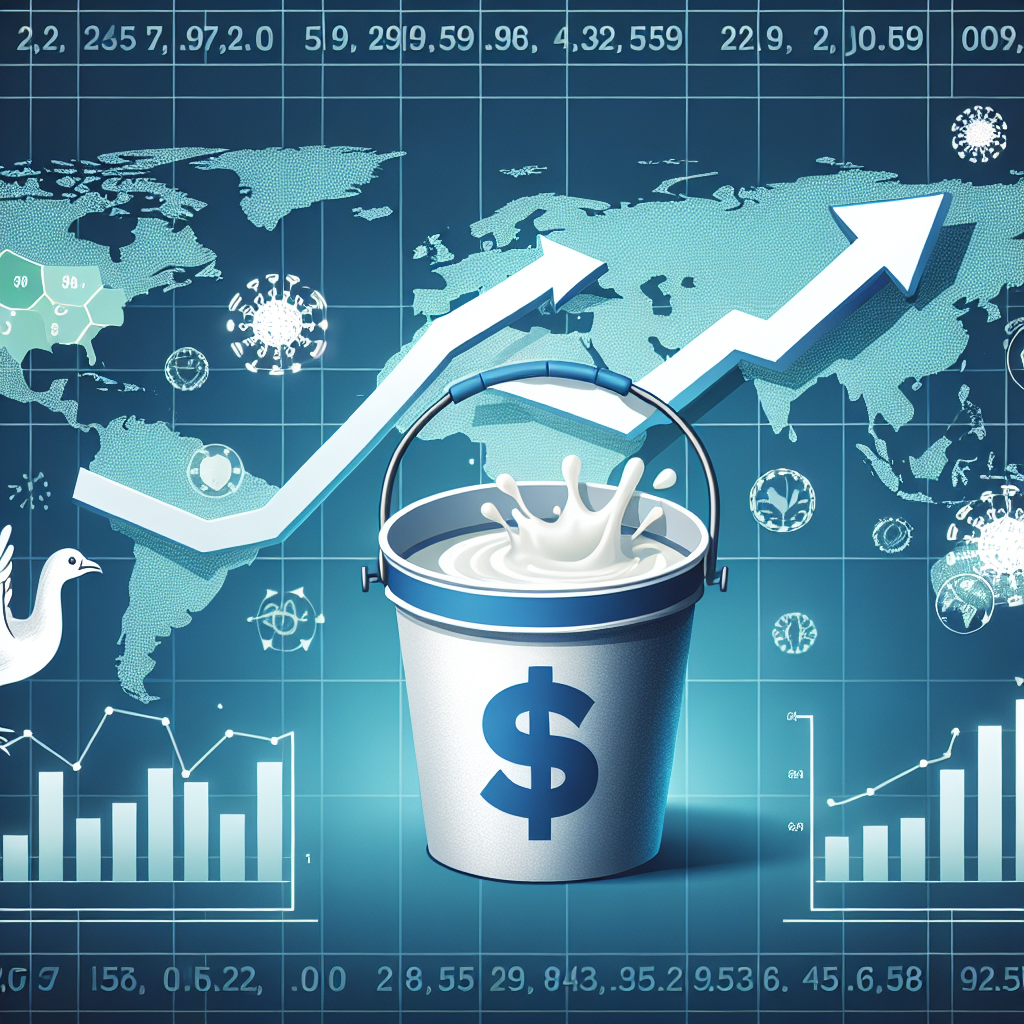Discover how changes in dairy prices affect your business strategy. Get key insights here.
Summary:
This week’s global dairy market recap reveals significant trends and regional developments, offering in-depth insights for industry professionals. As the EEX and SGX futures markets experience varied price movements and trading volumes, European quotations showcase mixed price changes across regions influenced by unique market pressures. Italy, Spain, and Poland report increased milk production, posing challenges and growth opportunities. In the U.S., while oversupply issues, particularly in the butter sector, pose challenges, cheese and milk powder exports remain strong. Meanwhile, whey protein markets are resurgent amidst robust production outputs, highlighting new opportunities. Understanding these shifts is vital: from Europe’s pricing divergences to U.S. oversupply, vigilance and adaptability are key for dairy professionals. Trading patterns indicate a complex landscape, with butter and SMP futures showing fluctuations on the EEX, while SGX prices for WMP and AMF remain relatively stable. Notably, European cheese indices decline, impacting international pricing strategies. Leveraging technology and sustainable practices will maintain competitiveness in this evolving market.
Key Takeaways:
- The EEX and SGX Futures experienced varying trading volumes, with a noticeable increase in open interest for Butter and SMP.
- European dairy quotations showed mixed movements, with Butter mostly declining but SMP, Whey, and WMP witnessing gains.
- Cheese indices in Europe faced a third consecutive week of declines, impacting cheese types like Cheddar Curd and Mozzarella.
- The GDT index increased by 1.2%, driven by significant gains in WMP, while butter and AMF faced declines.
- Italy, Spain, and Poland reported positive milk collection trends and milk solid production, indicating robust dairy sectors.
- The US saw increased butter and mozzarella production, though cheddar output declined, significantly influencing market prices.
- Whey prices continued to rise due to high demand for WPCs and WPIs, driving up Class III milk prices.
- Uncertainty looms over the cheese and milk powder markets as potential trade policy changes pressure US exports.
- Corn and soybean market movements hint at strong export potential, albeit amid looming tariffs.

The global dairy market is changing fast. December 2024 is a pivotal time for industry experts. This market recap isn’t just numbers; it’s a chance to grasp the trends shaping decisions. Change is always happening. Are these changes short-term, or are they a lasting shift in dairy economics? How will you adjust your farm or business in the coming months? Use this opportunity to think and plan strategically, ensuring you’re prepared and in control.
Trading Trajectories: Navigating the Shifting Tides of the EEX Dairy Markets
Last week, trading on the European Energy Exchange (EEX) showed significant trends for dairy farmers. Six thousand two hundred fifty-five tonnes of butter, Skimmed Milk Powder (SMP), and whey were traded, reflecting current market conditions.
Butter futures slightly improved, with prices up 0.3% to €6,906, signaling stability after recent drops. Increased open interests to 3,504 lots show more investor interest, offering a hopeful outlook that can ease pressures on dairy farmers.
On the other hand, SMP futures fell by 1.2%, settling at €2,738. Even though open interests rose to 6,198 lots, the lower prices might indicate too much supply or insufficient demand. This trend suggests that farmers should be ready for continued low prices that might affect their earnings.
The whey market saw a slight increase of 0.2% to €958, with stable open interests, indicating a balanced market. This steadiness helps farmers plan and budget confidently.
Overall, EEX trading patterns underline the need for dairy farmers to be vigilant and adaptable. The mixed butter, SMP, and whey trends highlight market pressures and opportunities. Consider using futures markets to protect against unpredictability and secure steady income amid changing market conditions. Your adaptability will make you resilient and ready for any change.
SGX Futures: A Symphony of Dairy Dynamics
The Singapore Exchange (SGX) futures market recently showed changes in dairy product prices. Whole milk powder (WMP) prices fell by 0.3% to $3,989, possibly due to more expected production or changing import needs. Dairy producers need to stay efficient and competitive in these conditions.
Skim milk powder (SMP) futures dropped by 2.0% to an average price of $2,998. Extra supply or falling demand in key markets like China might push stakeholders to adjust production plans.
Anhydrous milk fat (AMF) stayed steady at $7,263, showing balanced supply and demand. However, industry employees should watch for shifts due to consumer trends or policy changes.
Butter futures fell 4.3% to $6,613, possibly due to increased production or changing eating habits. Producers might consider export options or make different products to maintain healthy profits.
These SGX trends show global market changes affecting dairy professionals’ production and marketing management. They must be flexible and ready to adapt.
Decoding Europe’s Dairy Tapestry: A Maze of Price Moves and Regional Divergences
The European dairy market is complex, with varying prices and regional disparities. This week, we observed significant price fluctuations in butter, SMP (Skim Milk Powder), whey, and WMP (Whole Milk Powder). In the Netherlands, butter prices plummeted by 7.6%, while in Germany, they remained stable, indicating diverse market strategies. SMP prices experienced a slight increase, particularly in the Netherlands, but declined in Germany. This suggests that unique consumer needs and industrial uses are shaping the markets. Whey prices slightly increased in France but remained unchanged in Germany and the Netherlands, prompting us to ponder their future product focus. The WMP market surged in Dutch markets, hinting at a potential rise in export demand. These differences underscore the internal supply and demand challenges and their impact on international trade. As Europe grapples with these changes, stakeholders should consider forming strategic partnerships to remain competitive globally while exploring new opportunities.
Cheese Market Conundrum: Navigating the Decline in EEX Cheese Indices
European cheese producers face challenges as the EEX Cheese Indices show a drop across key varieties like Cheddar Curd, Mild Cheddar, Young Gouda, and Mozzarella. Cheddar Curd fell by 0.1%, while Mild Cheddar and Mozzarella were down 1.8% and 2.4%, respectively.
These drops might be due to changing costs for things like feed and energy and shifts in consumer habits due to economic worry or diet trends. Producers should rethink strategies to ease pressure on profits. This could mean cutting production costs, creating new product types, or offering a wider range of products.
Exporters should track these indices as they affect pricing in international markets, especially against other cheese-exporting areas. Dairy leaders should use tech to boost efficiency and sustainable methods to stay ahead of market changes. Quickly adapting is key to keeping profits strong in the changing dairy scene, and being proactive and forward-thinking will ensure you’re always ahead of the curve.
Decoding the GDT Results: What Do They Mean for Dairy Stakeholders?
The latest Global Dairy Trade (GDT) auction shows changes in key dairy products. Whole Milk Powder (WMP): Prices increased by 4.1% to $3,984, likely because of stronger demand as countries’ economies improve. Fonterra’s WMP is priced at $3,940, hinting at a strategy to keep their customers. Skim Milk Powder (SMP): Prices vary, averaging $2,848. Arla’s price is lower at $2,635, while Solarec is at $2,745. Even with a 2% price drop, the demand stays constant, pointing to possible short-term changes. Anhydrous Milk Fat (AMF): Prices slightly decreased by 0.5%. This stability might mean the market is balancing with new demands for milkfat products post-pandemic.
Butter prices fell by 5.2% due to oversupply, especially in the US, suggesting potential short-term price changes. Mozzarella prices also fell by 4.5%, indicating a possible surplus in supply compared to demand. While WMP remains strong, other dairy products might need to adjust. As economies stabilize, the dairy trade will present challenges and opportunities, necessitating quick thinking and wise choices from those in the market.
Italy’s Milk Boom: A New Era of Opportunities and Challenges
Italian milk production increased by 1.1% from the previous year in October, reaching 1.01 million tonnes. For 2024, there was a steady 1.6% growth over the first ten months, totaling 10.99 million tonnes. This growth boosts the Italian dairy sector, enhancing its processing and market capabilities.
It’s not just about producing more; the quality has improved too. Milkfat levels increased to 4.03% from 3.97% last year, and protein content rose to 3.50% from 3.48%. These changes make Italian dairy products more appealing, opening up premium market opportunities.
Italy’s increased output can affect dairy market dynamics globally. As Italy competes in the global market, others might have to change their prices and strategies. Italian dairy farmers face opportunities and challenges, balancing growth with resource management and innovation.
Italy’s growing milk production offers exciting opportunities for the dairy industry. However, maintaining growth in the face of international pressures will require careful planning.
Spain’s Dairy Surge: Catalyzing Continental Change and Competitive Pressure
Spanish milk production increased by 1.4% in October, reaching 600,000 tonnes. This growth shows strong demand for dairy products across Europe and might affect pricing. Improved technology, good weather, and helpful government policies have boosted production.
This increase could lead to competitive pricing, benefiting processors and consumers but making it hard for producers to stay profitable. The rise in supply also leads to product diversification, utilizing Spain’s skills in dairy production to draw more customers.
Spanish producers might need to change pricing to stay competitive while maximizing increased output. Managing inventory and production costs will be necessary for thriving in a crowded market. This growth could indicate future trends, encouraging industry stakeholders to update their production methods and market strategies.
Poland’s Dairy Revolution: Shattering Records and Setting New Standards
Poland’s 4.5% jump in milk solid production in October sets a new record, surpassing past averages. This increase shows better efficiency and sound conditions, boosting dairy production. If global demand keeps up with the supply, this could mean more income for Polish farmers. Exporting more milk solids strengthens Poland’s position in the global market, expanding where its dairy products are already popular.
In the past, Poland’s dairy sector grew with technology improvements and policy support. The current growth might lead to more investment in dairy infrastructure. Exporters can use this growth to build stronger partnerships and enter new markets, taking advantage of Poland’s growing influence in the dairy industry.
US Dairy Dynamics: Riding the Waves of Production and Market Challenges
The US dairy industry is at a crossroads with both challenges and opportunities. Butter production has increased by 3.1% this year in response to a 4% rise in demand. However, inventory levels are 11.4% higher than last year, which could lead to price drops. It’s crucial to match production with demand. In cheese, mozzarella production increased by 1.6%, but cheddar dropped by 3.1%, continuing a 12-year decline trend. This decline might push prices by reducing supply. Yet, cheese exports reached a record 86 million pounds in October, offering a chance for income growth. However, increased domestic production could result in an oversupply market. For milk powder, including nonfat dry milk (NDM) and skim milk powder (SMP), production is at its lowest since 2015, although stock levels are 8.1% higher than last year.
Exports to Mexico are at a 17-month high, showing potential for growth if pricing remains competitive and challenges in Southeast Asia are addressed. US producers must focus on strategic pricing, adjusting production, and boosting exports to avoid oversupply in butter and milk powder. Capitalizing on strong exports is key for cheese, but managing the risk of local oversupply is crucial. Changes in Oceania’s milk output and China’s demand also affect predictions. Adapting production to match demand, exploring new markets, and enhancing product value can help US producers turn challenges into opportunities in this evolving industry.
Whey Renaissance: High-Protein Opportunities Reshape Dairy Horizons
The whey market is changing and bringing new opportunities for dairy farmers and manufacturers. To satisfy the need for protein-rich products, the production of high-protein whey concentrates (WPCs) and isolates (WPIs) has substantially increased, up 48% this year.
People are choosing more protein supplements, driving this transformation. Manufacturers are focusing on WPCs and WPIs instead of the usual whey products.
This change benefits dairy stakeholders, leading to higher prices, like the current 71ȼ, for spot whey powder. This boosts Class III milk values and offers a critical income source in unstable markets.
Dairy farmers and processors must innovate to meet the demand for protein-rich products. Stakeholders can strengthen their market position and create new income paths by improving production and following trends. The whey market shows growth potential and the need for strategic adjustments.
Futures Fever: Navigating the Nuances of Class III and IV Dynamics
The Class III and IV futures present challenges and opportunities for dairy farmers. Class III futures, which are tied to cheese, have been unpredictable. Prices have recently increased, with December contracts reaching $18.87 per hundredweight (cwt). This is due to the strong demand for whey and cheese, with whey powder priced at 71 cents and Cheddar blocks rising. Class IV futures, related to butter and nonfat dry milk (NDM), have been inconsistent, mostly around $20.75, influenced by different market factors. With a historic 267.5 million pounds in storage, the butter must be supplied more. At the same time, NDM has seen an 8.1% increase in inventories compared to the past. For farmers, these futures indicate the need for strategic planning. The rise in Class III prices provides an opportunity to capitalize on strong cheese and whey demand, potentially increasing milk revenue.
On the other hand, Class IV’s fluctuations highlight the importance of monitoring butter and NDM markets. Farmers can use this information to monitor trends and adjust their approaches. Increasing production for Class III products might boost profits if cheese markets remain strong. With Class IV uncertainties, diversifying production and exploring flexible marketing strategies could reduce risks from oversupply. Watching futures helps farmers adapt and optimize their operations for stability and growth.
The Bottom Line
This week’s global dairy market shows the need to stay alert as things change. With different activities happening in EEX, SGX, and GDT, plus updates from Europe and the US, everyone in the industry has to be nimble. Italy, Spain, and Poland are making more, which brings both chances and challenges. The US needs more supply and needs new strategies. It’s essential to make timely decisions. Consider using these changes to secure your spot and grow despite global uncertainties. Be open to innovation and gain knowledge to succeed in today’s changing dairy market.
Learn more:
- Mid-Year 2024 Global Dairy Business Review: Key Developments from January to June
- Global Dairy Market Trends July 2024: Australia’s Rise as Argentina and New Zealand Face Challenges
- Is 2024 Shaping Up a Disappointing Year for Dairy Exports and Milk Yields?
 Join the Revolution!
Join the Revolution!
Bullvine Daily is your essential e-zine for staying ahead in the dairy industry. With over 30,000 subscribers, we bring you the week’s top news, helping you manage tasks efficiently. Stay informed about milk production, tech adoption, and more, so you can concentrate on your dairy operations.







 Join the Revolution!
Join the Revolution!










